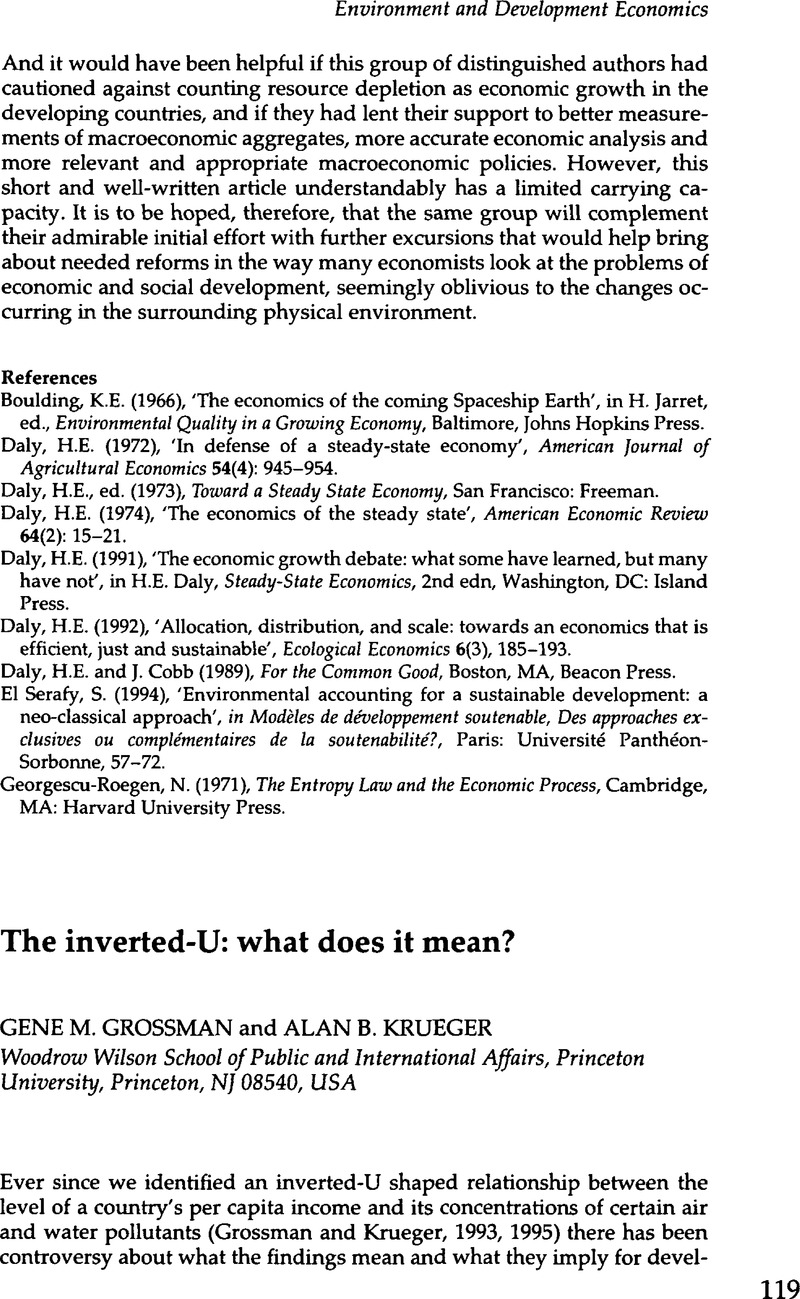Crossref Citations
This article has been cited by the following publications. This list is generated based on data provided by Crossref.
Berrens, Robert P
Bohara, Alok K
Gawande, Kishore
and
Pingo Wang
1997.
Testing the inverted-U hypothesis for US hazardous waste.
Economics Letters,
Vol. 55,
Issue. 3,
p.
435.
Bergh, Jeroen C. J. M.
and
Hofkes, Marjan W.
1998.
Theory and Implementation of Economic Models for Sustainable Development.
Vol. 15,
Issue. ,
p.
11.
Torras, Mariano
and
Boyce, James K
1998.
Income, inequality, and pollution: a reassessment of the environmental Kuznets Curve.
Ecological Economics,
Vol. 25,
Issue. 2,
p.
147.
Faria, João Ricardo
1998.
Environment, growth and fiscal and monetary policies.
Economic Modelling,
Vol. 15,
Issue. 1,
p.
113.
Wang, Pingo
Bohara, Alok K.
Berrens, Robert P.
and
Gawande, Kishore
1998.
A risk-based environmental Kuznets curve for US hazardous waste sites.
Applied Economics Letters,
Vol. 5,
Issue. 12,
p.
761.
Rothman, Dale S
1998.
Environmental Kuznets curves—real progress or passing the buck?.
Ecological Economics,
Vol. 25,
Issue. 2,
p.
177.
Gawande, Kishore
Bohara, Alok K.
Berrens, Robert P.
and
Wang, Pingo
2000.
Internal migration and the environmental Kuznets curve for US hazardous waste sites.
Ecological Economics,
Vol. 33,
Issue. 1,
p.
151.
Ayres, Robert U.
2000.
Innovation-Oriented Environmental Regulation.
Vol. 10,
Issue. ,
p.
11.
Stagl, Sigrid
2000.
Delinking Economic Growth from Environmental Degradation? A Literature Survey on the Environmental Kuznets Curve Hypothesis.
SSRN Electronic Journal,
Bimonte, Salvatore
2001.
Model of Growth and Environmental Quality. A New Evidence of the Environmental Kuznets Curve.
SSRN Electronic Journal ,
Bohara, Alok K.
Berrens, Robert P.
Gawande, Kishore
and
Wang, Pingo
2001.
One size doesn't fit all: estimating environmental Kuznets curves for hazardous waste site counts.
Environmetrics,
Vol. 12,
Issue. 4,
p.
383.
Bimonte, Salvatore
and
Punzo, Lionello F.
2003.
Environmental Policy Options in the Multi-regimes Framework.
SSRN Electronic Journal,
Hans Opschoor, J. B.
2003.
Social Institutions and Economic Development.
p.
23.
Teles, Vladimir Kühl
and
Arraes, Ronaldo
2004.
Optimal Environmental Protection and Environmental Kuznets Curve.
SSRN Electronic Journal,
2004.
Principles of Environmental Economics.
Dinda, Soumyananda
2004.
Environmental Kuznets Curve Hypothesis: A Survey.
Ecological Economics,
Vol. 49,
Issue. 4,
p.
431.
Bimonte, Salvatore
and
Punzo, Lionello F.
2005.
New Tools of Economic Dynamics.
Vol. 551,
Issue. ,
p.
297.
Binder, Seth
and
Neumayer, Eric
2005.
Environmental pressure group strength and air pollution: An empirical analysis.
Ecological Economics,
Vol. 55,
Issue. 4,
p.
527.
Sautet, Frederic E.
Hooks, Brian
and
Rothschild, Daniel M.
2005.
The Challenge Ahead: Maintaining a Focus on Incentives to Enable Development.
SSRN Electronic Journal,
Das Gupta, Ananda
and
Focacci, Antonio
2007.
Empirical analysis of the relationship between total consumption‐GDP ratio and per capita income for different metals.
International Journal of Social Economics,
Vol. 34,
Issue. 9,
p.
612.





